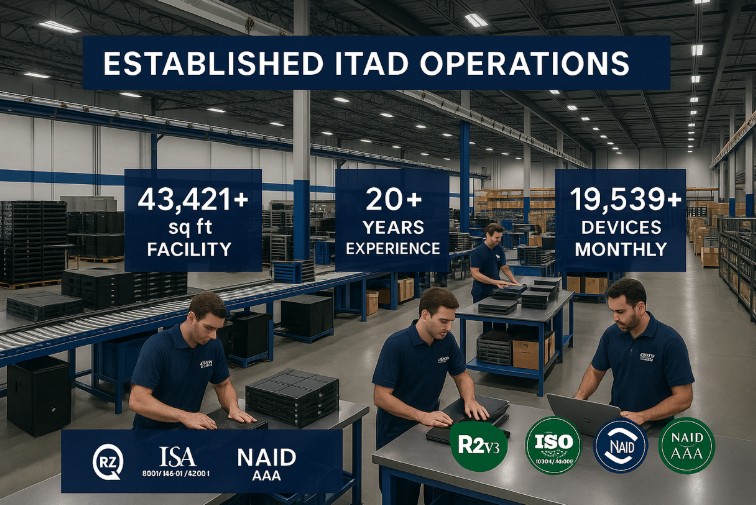Your network infrastructure represents millions of dollars in investment, yet most organizations unknowingly hemorrhage resources through inefficient lifecycle management practices. Companies implementing proactive upgrade strategies achieve up to a 25% savings on operating expenses and a 20% reduction in overall infrastructure costs, while organizations with poor asset management practices face an average annual loss of $12.9 million due to inadequate data quality and tracking systems.
As network complexity escalates and cybersecurity threats multiply, reactive maintenance and ad-hoc replacements no longer suffice. Modern enterprises need systematic methodologies that transform network equipment from cost centers into strategic assets that drive business value, security compliance, and sustainable growth.
This guide explores essential frameworks, proven strategies, and cutting-edge tools that industry leaders use to optimize network equipment lifecycle management, helping reduce the total cost of ownership while enhancing reliability, security, and performance.
Understanding Network Equipment Lifecycle
Network equipment lifecycle management refers to the systematic oversight of network infrastructure assets from initial planning through secure end-of-life disposal. Each stage of planning, procurement, deployment, maintenance, upgrades, and decommissioning requires strategic decision-making to maximize asset value, ensure data security, and sustain operational excellence.
Organizations with mature lifecycle programs experience higher network reliability, a stronger security posture, and tighter alignment between infrastructure and business goals.
Key Benefits of Effective Lifecycle Management
A proactive lifecycle management approach delivers measurable improvement across critical performance areas:
- Financial Benefits – Improved capital planning, reduced operating costs, and boosted asset utilization rates by standardizing procurement and refresh cycles.
- Operational Benefits – Increase uptime and ensure consistent performance through preventative maintenance and real-time monitoring. Early issue detection helps avoid business disruptions.
- Security and Compliance Benefits – Address vulnerabilities promptly, maintain regulatory compliance, and ensure secure handling of data across all lifecycle stages.
Essential Phases of Network Equipment Lifecycle
Successful network equipment lifecycle management requires a structured, phase-driven approach that supports optimal resource use, risk reduction, and maximum return on infrastructure investments. Understanding each phase enables IT teams to align operational goals with long-term infrastructure strategy.
Design Phase: Building a Scalable, Secure Foundation
The design phase establishes the foundation for effective lifecycle management. This stage involves comprehensive requirements analysis, technology evaluation, and strategic planning that shape network performance and cost-efficiency for years to come.
Key activities include:
- Requirements Gathering and Analysis – In-depth assessment of current and future business needs, performance requirements, and technical constraints
- Technology Evaluation and Selection – Comparison of solutions based on performance, cost, compatibility, and vendor support
- Network Architecture Planning – Development of high-level design documents specifying equipment layout, connectivity, and integration points
- Capacity Planning and Scalability Assessment – Long-term analysis of growth trends and infrastructure flexibility
- Security Architecture Integration – Embedding of security protocols and compliance standards into the initial design
Implementation Phase: Deploying with Precision
The implementation phase brings the network design to life. It requires project oversight, detailed testing, and structured deployment to ensure successful execution with minimal disruption to business operations.
Best practices include:
- Phased Deployment Strategies – Staggered rollouts that allow testing and course corrections during implementation
- Comprehensive Testing Protocols – Validation of performance, reliability, and security before full production deployment
- Change Management Procedures – Structured processes for configuration updates, documentation, and team communication
- Training and Knowledge Transfer – Onboarding programs to ensure operational teams are equipped to manage the network effectively
Operations Phase: Ensuring Performance and Reliability
The operations phase is the longest and most critical stage of the lifecycle. It encompasses everything from daily performance monitoring to preventative maintenance and system optimization.
Key focuses include:
- Real-Time Network Monitoring – Implementation of monitoring tools that deliver continuous visibility into uptime, capacity, and potential issues
- Performance and Capacity Management – Ongoing tracking of usage trends to guide future upgrades and expansion
- Security and Compliance Oversight – Regular patching, vulnerability scanning, and adherence to regulatory requirements
- Proactive Maintenance – Scheduled updates, hardware diagnostics, and performance tuning to extend asset lifespan
Decommissioning Phase: Secure, Compliant Equipment Retirement
Decommissioning marks the final phase of the lifecycle. It requires careful coordination to ensure data security, environmental responsibility, and value recovery while maintaining business continuity.
Secure data destruction becomes a paramount concern during decommissioning, particularly for organizations handling sensitive information or operating under strict regulatory requirements. Data wiping procedures must meet industry standards and regulatory requirements to ensure complete data sanitization and prevent unauthorized data recovery.
Best practices include:
- Comprehensive Asset Inventory and Assessment – Full cataloging of assets to evaluate condition, value, and disposal options
- Secure Data Destruction and Certification – Use of certified data erasure processes (e.g., NIST 800-88) with full documentation
- Environmental Compliance and Recycling – Responsible disposal aligned with e-waste regulations and ESG goals
- Value Recovery and Asset Disposition – Identification of reusable or remarketable hardware to reclaim value
- Documentation and Audit Trail Maintenance – Maintenance of detailed records to support audits, compliance, and reporting
Frameworks for Network Lifecycle Management
Implementing established lifecycle frameworks provides organizations with structured methodologies for managing network equipment through decommissioning. These models align technical processes with business goals while promoting consistency, efficiency, and adherence to best practices.
Overview of PPDIOO
The PPDIOO (Prepare, Plan, Design, Implement, Operate, Optimize) framework offers a structured approach to network lifecycle management that integrates technical workflows with strategic business outcomes. Developed by Cisco, this methodology provides systematic guidance for optimizing network infrastructure throughout its full lifecycle.
- Prepare: Focuses on organizational readiness and aligning IT strategy with business objectives
- Plan: Covers detailed project planning, resource allocation, and risk mitigation
- Design: Translates business requirements into technical architectures
- Implement: Deploys infrastructure using defined configurations and rollout plans
- Operate: Maintains day-to-day network performance and support
- Optimize: Identifies opportunities for improvement and prepares for future upgrades
Introduction to ITIL
The Information Technology Infrastructure Library (ITIL) is a globally recognized framework for IT service management that complements network lifecycle strategies. ITIL’s service lifecycle model, comprising Strategy, Design, Transition, Operation, and Continual Improvement, supports structured governance for infrastructure performance and compliance.
Key ITIL benefits include:
- Strategic alignment of network decisions with measurable value
- Defined roles and responsibilities for managing network services and support
- A process-based approach to ensuring availability, capacity, and security
- Built-in mechanisms for continual improvement and service evolution
By incorporating ITIL principles, organizations can improve service reliability, enhance user experience, and ensure that network investments align with evolving business requirements.
Best Practices for Efficient Lifecycle Management
Optimizing network equipment lifecycle management requires implementing proven best practices that enhance operational efficiency and reduce total cost of ownership (TCO). These strategic approaches enable organizations to maintain peak performance, minimize operational risk, and maximize asset value throughout the equipment’s useful life.
Regular Maintenance and Monitoring
Proactive maintenance and real-time monitoring form the cornerstone of effective lifecycle management. Organizations that implement systematic maintenance protocols experience significantly reduced downtime, greater network stability, and extended equipment lifespan.
According to industry research, proactive maintenance strategies can lower TCO by up to 30% while enhancing network performance and resilience.
Effective monitoring involves deploying advanced tools that provide real-time visibility into:
- Network performance
- Security status
- Capacity utilization
Modern monitoring platforms often incorporate artificial intelligence and machine learning capabilities to detect anomalies, forecast hardware degradation, and recommend timely interventions, transforming reactive support into predictive operations.
Proactive Planning and Risk Management
Strategic planning and comprehensive risk management empower organizations to anticipate infrastructure demands, optimize resource allocation, and preserve long-term network health.
Key strategies include:
- Capacity Forecasting – Analyze growth trends to ensure sufficient bandwidth and hardware scalability
- Technology Roadmap Development – Align lifecycle plans with emerging technology standards and upgrade cycles
- Vendor Management – Evaluate vendor reliability, service SLAs, and pricing to build resilient support relationships
- Budget Planning – Balances capital expenses with operating costs to ensure sustainable lifecycle investment
Selecting the Right Tools for Network Lifecycle Visibility
Modern network lifecycle management increasingly relies on specialized tools and platforms that automate routine tasks and provide comprehensive visibility into network assets. These solutions enable organizations to manage complex network environments more efficiently while reducing operational overhead and improving decision-making capabilities.
Overview of Meter’s Integrated Network Solutions
Meter’s comprehensive network solutions offer an integrated approach to lifecycle management, simplifying deployment, operation, and optimization. Their platform combines hardware, software, and services into unified solutions that reduce complexity while improving performance and reliability.
With a strong focus on simplicity and automation, the platform minimizes operational overhead while maintaining enterprise-grade performance and security. Meter’s buyback program provides additional value through structured equipment refresh and value recovery approaches.
Benefits of Lansweeper’s Infrastructure Upgrade Solutions
Lansweeper’s asset management solutions provide comprehensive visibility and control over network infrastructure assets throughout their lifecycle. The platform’s automated asset discovery capabilities ensure complete and accurate inventory management, a critical foundation for effective lifecycle management.
Its integration capabilities allow organizations to consolidate asset information from multiple sources into unified dashboards, eliminating information silos and providing a complete view of asset status, performance, and lifecycle stage.
Addressing Common Challenges
Despite the clear benefits of structured lifecycle management, organizations frequently encounter obstacles that can undermine their efforts and compromise results. Recognizing and proactively addressing these common challenges is essential for successful network equipment lifecycle management implementation.
Importance of Comprehensive Planning Phases
Inadequate planning remains one of the most significant challenges in network equipment lifecycle management, often resulting in cost overruns, performance issues, and security vulnerabilities. Organizations that invest insufficient time and resources in the early planning phases frequently encounter problems that could have been prevented through more thorough preparation and analysis.
Common planning deficiencies include limited requirements analysis, lack of future-state planning, weak risk assessment, minimal stakeholder engagement, and unrealistic budget and timeline expectations.
Ensuring Security and Compliance
Security and compliance requirements add significant complexity to network equipment lifecycle management, requiring systematic approaches to vulnerability management, access control, and regulatory compliance. Organizations must balance infrastructure protection with operational efficiency while maintaining compliance with evolving regulatory standards and industry best practices.
Modern network environments face increasingly sophisticated security threats that require comprehensive security management throughout the equipment lifecycle, including secure configuration management, regular vulnerability assessment, and systematic security monitoring.
Strategies for Enhancing Network Security
Security considerations must be integrated into every phase of the network equipment lifecycle to protect against evolving threats and maintain regulatory compliance. Implementing comprehensive security strategies ensures that network infrastructure remains resilient and secure from initial deployment through final decommissioning.
Effective network security requires a layered approach that combines preventive controls, real-time detection, and responsive procedures.
Key security strategies include:
- Comprehensive Vulnerability Management – Systematic identification, assessment, and remediation of security vulnerabilities across the network
- Access Control and Authentication – Implementation of role-based access controls and secure authentication to limit unauthorized access
- Security Monitoring and Incident Response – Deployment of real-time monitoring tools and formal response protocols for rapid threat mitigation
- Security Architecture and Design – Integration of security principles into network planning, design, and hardware selection
Ensuring Scalability and Innovation
Future-proofing network infrastructure requires strategic planning that accommodates growth while enabling the adoption of emerging technologies. Organizations must balance current operational needs with long-term scalability requirements to maintain competitive advantage and support evolving business requirements.
Techniques for Supporting Network Scalability
Scalability planning involves capacity forecasting, modular architecture design, and technology selection that allows organizations to accommodate future growth efficiently without performance trade-offs. Modern strategies increasingly incorporate cloud-native solutions and software-defined networking to support flexible, scalable operations.
Encouraging Innovation through Updated Infrastructure
Infrastructure modernization creates opportunities for innovation by enhancing capabilities, performance, and adaptability. Upgraded network environments can support advanced technologies such as IoT devices, artificial intelligence applications, and real-time analytics platforms.
Building Resilient, Scalable Networks Through Lifecycle Strategy
From design and deployment to decommissioning and modernization, each phase presents opportunities to improve performance, enhance security, and reduce the total cost of ownership. By addressing common challenges head-on and adopting proven frameworks and best practices, organizations can transform their networks into resilient, scalable assets that drive long-term success.
OEMSource supports enterprises at every stage of the network lifecycle with certified hardware solutions, secure decommissioning services, and global logistics expertise. Whether you’re planning your next refresh or strengthening compliance, we help you move faster, spend smarter, and operate with confidence.
Contact us today to learn how OEMSource can elevate your network lifecycle strategy.
Frequently Asked Questions
How often should network equipment be replaced or upgraded?
Network equipment replacement cycles typically range from 3-7 years, depending on the device type, usage patterns, and evolving business requirements. Replacement decisions should factor in performance benchmarks, security risks, end-of-support timelines, and total cost of ownership analysis. Proactive refresh strategies help minimize downtime and avoid legacy-related vulnerabilities.
What are the key metrics for measuring network lifecycle management success?
Core performance indicators include total cost of ownership reduction, increased network uptime, fewer security incidents, improved compliance rates, and business continuity alignment. Organizations should also track operational metrics such as mean time to resolution (MTTR), capacity planning efficiency, and asset utilization rates.
How can organizations ensure data security during equipment decommissioning?
Data security begins with certified IT asset disposition (ITAD) procedures that meet NIST 800-88 and industry standards. Corporate IT Asset Disposition services can provide secure data wiping, audit-ready documentation, chain-of-custody verification, and environmentally compliant disposal through authorized recycling or resale channels.
What role does network design play in long-term lifecycle success?
Network design establishes the foundation for scalability, performance, and security. A well-structured design supports long-term efficiency by anticipating future capacity, integrating compliance standards, and enabling easier upgrades or technology transitions as the infrastructure evolves.
How can businesses reduce costs while improving network reliability?
Standardizing hardware, consolidating vendors, and leveraging third-party maintenance are proven strategies to cut costs without compromising performance. Lifecycle planning that includes proactive maintenance and timely upgrades reduces emergency fixes and extends equipment lifespan ultimately improving reliability and return on investment (ROI).





